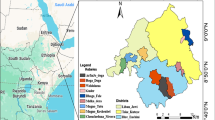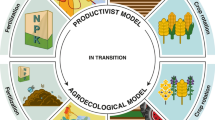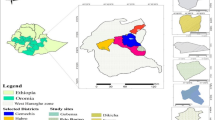Abstract
Hevea brasiliensis natural rubber production is strategic for the world economy. Meloidogyne exigua causes the main root disease in this crop in Brazil. Its early diagnosis allows better pest management, reducing losses. This study aimed to identify rubber tree orchard areas infested by M. exigua using remote sensing and vegetation spectral indices—normalized difference vegetation (NDVI) and simple ratio (SR)—generated from the RapidEye® satellite constellation images. Orchards under tapping in Minas Gerais state (irrigated) and Goiás state (without irrigation) were sampled during the rainy season and soil, root and total nematode density were estimated. Although significant interactions between nematode density and vegetation spectral indices were found, none had determination coefficient (R2) greater than 0.31. Descriptive statistics of both orchards did not identify differences between the areas and root or total nematode density; however, nematode density in the soil in the Goiás orchard was 236% greater than in the Minas Gerais orchard, while both spectral vegetation indices were lower in the former. Such differences might be a consequence of irrigation. Pearson’s, Spearman’s and Kendall’s correlations between nematode density and NDVI presented greater coefficients than SR for every parameter in both orchards. NDVI can be used to distinguish non-infested rubber tree orchard from one infested by M. exigua.



Similar content being viewed by others
References
Ahad NA, Yin ST, Othman AR, Dan Yaacob CH (2011) Sensitivity of normality tests to non-normal data. Sains Malays 40(6):637–641
Alvarenga AP, Carmo CAFS (2014) Seringueira. EPAMIG, Viçosa
Basso B, Cammarano D, De Vita P (2004) Remotely sensed vegetation indices: theory and applications for crop management. Ital J Agrometeorol 1:36–53
Beck HE, Zimmermann NE, Mcvicar TR, Vergopolan N, Berg A, Wood EF (2018) Present and future Köppen–Geiger climate classification maps at 1-km resolution. Sci Data 1:1–12. https://doi.org/10.1038/sdata.2018.214
Birth GS, Mcvey GR (1968) Measuring the color of growing turf with a reflectance spectrophotometer. Agron J 60(6):640–643. https://doi.org/10.2134/agronj1968.00021962006000060016x
Bonetti JIS, Ferraz S (1981) Modificações do método de Hussey & Barker para extração de ovos de Meloidogyne exigua em raízes de cafeeiro. Fitop Bras 6:553
Carneiro RMDG, Almeida MRA (2000) Caracterização isoenzimática e variabilidade intraespecífica dos nematoides de galhas do cafeeiro no Brasil. In: Simpósio de Pesquisa dos Cafés do Brasil, 2000, Poços de Caldas. Expanded resume, pp 280–282
Chambers J, Cleveland W, Kleiner B, Tukey P (1983) Graphical methods for data analysis. Wadsworth e Brooks/Cole, Pacific Grove
Do Amaral ES, Silva DV, Dos Anjos L, Schilling AC, Dalmolin ÂC, Mielke MS (2019) Relationships between reflectance and absorbance chlorophyll indices with RGB (Red, Green, Blue) image components in seedlings of tropical tree species at nursery stage. New For 50:377–388. https://doi.org/10.1007/s11056-018-9662-4
Empresa Brasileira de Pesquisa Agropecuária (2013) Sistema brasileiro de classificação de solos, 3rd edn. EMBRAPA, Brasilia
Felix AM, Kazmierczak ML, Espíndola GM (2009) RapidEye: a nova geração de satélites de observação da Terra. In: Simpósio Brasileiro de Sensoriamento Remoto, 2009, Natal. Annals. INPE, pp 7619–7622
Ferraz LCCB, Brown DJF (2016) Nematologia de plantas: fundamentos e importância. Norma Editora, Manaus
Ferreira DF (2011) Sisvar: a computer statistical analysis system. Ciênc Agrotec 35(6):1039–1042. https://doi.org/10.1590/S1413-70542011000600001
Ferris H, Muuens TA, Foord KE (1990) Stability and characteristics of spatial description parameters for nematode populations. J Nematol 22:427–439
Figueiredo Filho DB, Silva Júnior JA (2009) Desvendando os mistérios do coeficiente de correlação de Pearson (r). Rev Pol Hoje 18(1):115–146. https://doi.org/10.11606/issn.2237-4485.lev.2014.132346
Fonseca HS, Jaehn A, Silva MFA (1999) Reações de porta-enxertos de seringueira a Meloidogyne javanica e M. exigua. Nematol Bras 23(2):9–14
Fonseca HS, Ferraz LCCB, Machado SR (2003) Comparative ultrastructure of rubber tree roots parasitized by Meloidogyne exigua and M. javanica. Nematol Bras 27(2):199–206
Gasparotto L, Pereira JCR (2012) Doenças da seringueira no Brasil, 2nd edn. EMBRAPA, Manaus
Gasparotto L, Pereira JCR, Moreira A, Furtado EL, Santos AF (2016) Manual de identificação de doenças da cultura da seringueira. EMBRAPA, Brasília (FD)
Hatfield JL, Gitelson AA, Schepers JS, Walthall CL (2008) Application of spectral remote sensing for agronomic decisions. Agron J 100:117–131. https://doi.org/10.2134/agronj2006.0370c
Inamasu RY, Bernardi ACC (2014) Agricultura de precisão. In: Bernardi ACC, Naime JM, Resende AV, Bassoi LH, Inamasu RY (Org) Agricultura de precisão: resultados de um novo olhar. EMBRAPA, Brasília, pp 21–33
INSTITUTO AGRONÔMICO DE CAMPINAS (2016) Centro de seringueira e sistemas agroflorestais. http://www.iac.sp.gov.br/areasdepesquisa/seringueira/clones.php. Accessed 10 Oct 2016
Jenkins WRA (1964) A rapid centrifugal-flotation technique for separating nematodes from soil. Plant Dis Rep 48(9):692–698
Jensen JR (2009) Sensoriamento remoto do ambiente: uma perspectiva em recursos terrestres, 2nd edn. Epiphanio JCN, Formaggio AR, Santos AR, Rudorff BFT, Almeida CM, Galvão LS. INPE, São José dos Campos
Jordan CF (1969) Derivation of leaf-area index from quality of light on forest floor. Ecology 50(4):663–666
Kendall MG (1975) Rank correlation methods, 4th edn. Griffin, London
Kohjiya S, Ikeda Y (2014) Chemistry, manufacture and applications of natural rubber. Woodhead Publishing, Oxford
Kolmogorov A (1956) Foundations of the theory of probability, 2nd edn. Chelsea, New York
Kriegler FJ, Malila WA, Nalepka RF, Richardson W (1969) Preprocessing transformations and their effects on multispectral recognition. In: Proceedings of the sixth international symposium on remote sensing of environment, University of Michigan, Ann Arbor, pp 97–131
Machado TV, Coelho L, Santos MA (2014) Densidade populacional de Meloidogyne exigua em raízes de diferentes clones de Hevea brasiliensis. In: XXXVII Congresso Paulista de Fitopatologia, Botucatu, poster 076
Mahlein AK (2016) Plant disease detection by imaging sensors—parallels and specific demands for precision agriculture and plant phenotyping. Plant Disease, vol 100, no 2. St. Paul, pp 241–251
Marshall M, Okuto E, Kang Y, Opiyo E, Ahmed M (2016) Global assessment of vegetation index and phenology lab (VIP) and global inventory modeling and mapping studies (GIMMS) version 3 products. Biogeosciences 13:625–639
Muniz MFS, Campos VP, Castagnone-Sereno P, Castro JMC, Almeida MRA, Carneiro RMDG (2008) Diversity of Meloidogyne exigua (Tylenchida: Meloidogynidae) populations from coffee and rubber tree. Nematology 10:897–910. https://doi.org/10.1163/156854108786161418
Paes-Takahashi VS, Soares PLM, Guiducci EP, Brito PF, Carneiro FA, Ferreira Junior R (2015) Reaction of rubber tree rootstock to Meloidogyne exigua and Pratylenchus brachyurus. Nematropica 45:242–251
Pearson K (1892) The grammar of science. Walter Scott, London
Perry RN, Moens M (2005) Plant nematology. Biddles, Pondicherry
Petorrelli N, Vik JO, Mysterud A, Gaillard JM, Tucker CJ, Stenseth NC (2005) Using the satellite-derived NDVI to assess ecological responses to environmental change. Trends Ecol Evol 20:503–510. https://doi.org/10.1016/j.tree.2005.05.011
Pezzoni Filho JC (2014) Dinâmica espaço-temporal da ocorrência de nematoides em seringueira. Dissertation. Universidade Estadual Paulista Júlio de Mesquita Filho
Ponzoni FJ, Shimabukuro YE (2007) Sensoriamento remoto no estudo da vegetação. Parênteses, São José dos Campos
Rouse JW, Haas RH, Schell JA, Deering DW (1973) Monitoring vegetation systems in the great plains with ERTS. In: Earth resources technology satellite—1 symposium, Washington, 1973. Proceedings, vol 1. NASA, Washington, pp 309–317
Santos JM (1992) Histopatologia em raízes de seringueira infectadas por Meloidogyne exigua. Fitopatol Bras (abstract) 17(2):226
Schowengerdt RA (2006) Remote sensing: models and methods for image processing, 3rd edn. Elsevier, London
Shapiro SS, Wilk MB (1965) An analysis of variance test for normality. Biometrika 52:591–611. https://doi.org/10.2307/2333709
Shigematsu A, Mizoue N, Kajisa T, Yoshida S (2011) Importance of rubberwood in wood export of Malaysia and Thailand. New For 41(2):179–189. https://doi.org/10.1007/s11056-010-9219-7
Siegel S (1975) Estatística não-paramétrica: para as ciências do comportamento. McGraw-Hill do Brasil, São Paulo
Smirnov S (1936) Beschreibung einer neuen Acartia-Art aus dem Japanischen Meer nebst einiger Bemerkungen über die Untergattung Euacartia Steuer. Zool Anz 114:87–92
Spearman C (1904) General intelligence objectively determined and measured. Am J Psychol 15(1):72–101
Townshend RJ, Masek JG, Huang C, Vermote EF, Gao F, Channan S, Sexton JO, Feng M, Narasimhan R, Kim D, Song K, Song D, Song X-P, Noojipady P, Tan B, Hansen MC, Li M, Wolf RE (2012) Global characterization and monitoring of forest cover using Landsat data: opportunities and challenges. Int J Digit Earth 5(5):373–397. https://doi.org/10.1080/17538947.2012.713190
Tukey JW (1953) The problem of multiple comparisons. Mimeographs Princeton University, Princeton
Wang K, Xiang W-N, Guo X, Liu J (2012) Remote sensing of forestry studies. In: Okia CA (ed) Global perspectives on sustainable forest management. InTech, Rijeka, pp 205–216. https://doi.org/10.5772/32995
Wilcken SRS, Gabia AA, Brito PF, Furtado EL (2015) Phytoparasite nematodes in rubber plantations of São Paulo State. Summa Phytopathol 41(1):54–57. https://doi.org/10.1590/0100-5405/2025
Wójtowicz M, Wójtowicz A, Piekarczyk J (2016) Application of remote sensing methods in agriculture. Commun Biom Crop Sci 11:31–50. https://doi.org/10.2478/gein-2014-0007
Xue, J, Su B. (2017) Significant remote sensing vegetation indices: a review of developments and applications. J Sens. Article ID 1353691, 17 p. https://doi.org/10.1155/2017/1353691
Acknowledgements
This publication is part of the doctorate dissertation of the first author, which was conducted during scholarship supported by the Coordination for the Improvement of Higher Education Personnel (CAPES).
Author information
Authors and Affiliations
Corresponding author
Additional information
Publisher's Note
Springer Nature remains neutral with regard to jurisdictional claims in published maps and institutional affiliations.
Rights and permissions
About this article
Cite this article
Lemes, E.M., Machado, T.V., Gontijo, L.N. et al. Detection of rubber tree orchards infested by Meloidogyne exigua using vegetation indexes obtained from satellite images. New Forests 51, 765–779 (2020). https://doi.org/10.1007/s11056-019-09760-7
Received:
Accepted:
Published:
Issue Date:
DOI: https://doi.org/10.1007/s11056-019-09760-7




